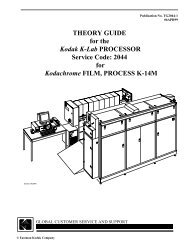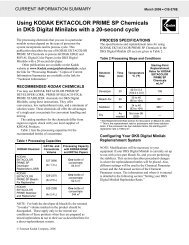12 VISUAL TROUBLESHOOTING OF PROCESS E-6 - 125px
12 VISUAL TROUBLESHOOTING OF PROCESS E-6 - 125px
12 VISUAL TROUBLESHOOTING OF PROCESS E-6 - 125px
You also want an ePaper? Increase the reach of your titles
YUMPU automatically turns print PDFs into web optimized ePapers that Google loves.
<strong>12</strong> <strong>VISUAL</strong> <strong>TROUBLESHOOTING</strong><br />
<strong>OF</strong> <strong>PROCESS</strong> E-6<br />
Once you have eliminated improper film storage and incorrect exposure as causes of poor-quality transparencies on KODAK<br />
EKTACHROME Film, check for processing problems. These problems include errors in chemical mixing, order of processing<br />
steps, processing temperature, agitation, washing, replenishment, and solution contamination.<br />
A visual check of the processed film is one way to make an initial diagnosis. You can make a more thorough determination of<br />
the cause of processing problems and the corrective action to take by plotting and evaluating your control-strip densities; see<br />
section 13, “Process Monitoring.”<br />
Table <strong>12</strong>-1<br />
Troubleshooting from the Appearance of Processed Film<br />
Appearance of Film Possible Cause<br />
Very High Maximum<br />
Density (very dark<br />
no apparent image)<br />
No Edgeprint<br />
Visible<br />
Edgeprint<br />
Visible<br />
First developer omitted<br />
First developer and color developer reversed<br />
Film not exposed<br />
Dark Overall Inadequate time or low temperature in first developer<br />
First or color developer diluted or exhausted<br />
Color developer starter added to first developer<br />
Too much first developer starter used<br />
First developer or first and color developers underreplenished<br />
Very Dark (overall or in random areas) Bleach or fixer (or both) omitted, reversed, diluted, exhausted, or underreplenished<br />
LIght Overall Too much time or high temperature in first developer<br />
Film fogged by light before processing<br />
First or color developer (or both) too concentrated<br />
First or color developer (or both) overreplenished<br />
First developer starter omitted<br />
First developer contaminated with reversal bath or color developer<br />
First developer contaminated with fixer<br />
Image Very Faint or No Image<br />
(film may show colored streaks)<br />
First developer used twice or color developer omitted<br />
Severe light fog<br />
Overall Density Variation from Batch to Batch Inconsistent first-developer time, temperature, agitation, or replenishment<br />
Blue First developer contaminated with fixer<br />
Reversal bath overconcentrated<br />
Too little first developer starter used<br />
Cyan First-wash temperature too low<br />
Yellow Color-developer starter added to first developer<br />
Too much first developer starter used<br />
Inadequate bleaching or fixing<br />
Yellow-Red First developer with color developer starter added<br />
Underreplenishment of first developer or color developer<br />
Low Density Blue; High Density Yellow Color developer contaminated with fixer<br />
Green Reversal bath exhausted, diluted, or underreplenished<br />
Film fogged by green safelight<br />
Wash used between color developer and reversal bath<br />
Color developer dilute<br />
Color pH high<br />
Too much Part A in color developer<br />
Overreplenished color developer<br />
A dilute color developer<br />
Color developer mixed using first developer starter<br />
Using KODAK Chemicals, Process E-6 • Z-119 Sixth Edition <strong>12</strong>-1
Appearance of Film Possible Cause<br />
Red Inadequate aeration of bleach<br />
Pre-bleach concentration too high<br />
Inadequate aeration of fixer<br />
First-wash temperature too high<br />
Severely oxidized color developer<br />
Magenta Color developer pH low<br />
Color developer concentrated<br />
Too much Part B in color developer<br />
Underreplenished color developer<br />
Cross-Width Bar Marks (with stainless-steel reels) Gaseous-burst agitation used in first developer<br />
Incorrect or inadequate manual agitation<br />
Scum and Dirt* Bio-growth (slime) in final rinse (drain and replace)<br />
Air filters in dryer need changing<br />
Dirt in solutions; use floating covers on processor and replenisher solution tanks<br />
Final rinse overconcentrated<br />
Precipitate in pre-bleach<br />
Dirt from dryer<br />
Fixer sulfurized<br />
Defoamer added directly to any solution or too much defoamer used<br />
Surface Spots (appear dark by transmitted light) Dirt from final rinse<br />
Water spotting. Final rinse too dilute<br />
Dirt from dryer<br />
Fixer sulfurized<br />
Dryer temperature too high<br />
Streaks—Nonuniformity Bleach or fixer time too short, temperature too low, or replenisher too dilute<br />
Uneven or insufficient agitation, particularly in first and color developers<br />
Nonuniform agitation in first and color developers<br />
Low first-wash flow rate<br />
Foam rundown<br />
Scratches and Abrasions Dirty squeegee blades<br />
Jammed, misaligned, or dirty rollers<br />
Cinch marks due to excessive take-up tension<br />
Dirt from loading area<br />
Dirt from camera<br />
Light Density Spots, Streaks, or Patterns Static<br />
Fog<br />
Stain Loss of bleach, fixer, or pre-bleach activity<br />
Fixer sulfurized by excessive aeration<br />
Bleach not sufficiently aerated<br />
Color-developer time too long or temperature too high<br />
Inadequate first-developer agitation<br />
* A buildup of fungus or algae in processing solutions or wash tanks can cause dirt. To minimize buildup, drain wash tanks when they are not in use. When<br />
you expect the processor to be out of use for more than six weeks, drain and rinse the reversal-bath processor tank and replenisher storage tanks. To remove<br />
fungus or algae, scrub the tank with a stiff-bristle brush, using a 30 to 50 mL/L sodium hypochlorite solution (household bleach).<br />
Rinse the tank thoroughly with water to remove all traces of the hypochlorite solution. Do not use a sodium hypochlorite solution in the wash tank that<br />
follows the fixer. Use a 5- to 25-micrometre (or finer) filter for your water supply.<br />
<strong>12</strong>-2 Using KODAK Chemicals, Process E-6 • Z-119 Sixth Edition

















